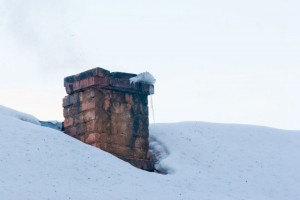During the cold months of winter, most people retreat inside to spend time with their families around a roaring fire. Unfortunately, the freezing temperatures that make us want to stay inside can also have a negative effect on our chimneys.
Steep drops in temperatures, freezing rain, sleet, snow, ice, and harsh winds can all contribute to chimney damage during the winter. In addition, these winter weather conditions can make existing chimney damage worse or contribute to accelerated decay.
Below are several common winter masonry issues, what causes them, and how to prevent them from happening or fix any damage they cause.
The freeze thaw cycle
The freeze thaw cycle is the primary cause of masonry damage during the winter. Because bricks and mortar are naturally porous substances, they are meant to absorb small amounts of water. Older or damaged bricks with cracks or holes may absorb even more. When bricks and mortar absorb water from rain or snow and the temperature drops below freezing, the water in the masonry also freezes. The water expands as it freezes, creating larger areas of damage. When the ice melts so does the water within the masonry, leaving larger holes that can now be filled with even more water. This process is called the freeze thaw cycle.
Signs of damage to the masonry of your chimney may include brick that is chipped, cracked, missing pieces, crumbling, or otherwise falling apart. The best way to protect against water damage is to have your chimney regularly inspected and maintained. If your chimney has damaged or missing bricks or crumbling mortar, the masons at Pristine Sweeps can repair the damage, and their work is accompanied by a five year warranty.
How to prevent water damage
To further protect your masonry from the damaging freeze thaw cycle, considering having the bricks and mortar of your chimney waterproofed. Pristine Sweeps uses the special Chimney Saver products which are able to prevent water from getting in while still allowing gas to get out. This is different from latex paints and other sealants which no longer let the brick pass gas.
Other masonry problems
While damage to the bricks and mortar of their chimney masonry is often homeowner’s primary concern during the cold months of winter, there are a number of other ways that winter can affect your chimney system’s masonry. One problem that can occur due to a chimney’s height is the stack effect. The Stack Effect occurs when there is a difference in air pressure between the inside and outside of a home. This can be worsened by heavy winter winds creating external pressure on the chimney. The cold air rushing down the chimney may cause smoke to blow back into the home.
If your chimney cap, chimney crown, or chimney chase cover become cracked or damaged, you may notice water entry into your chimney and fireplace. You may notice that the inside of your firebox is damp or that there is a musty smell when the fireplace is not in use. This type of water entry is equally detrimental to a fireplace system in that it effects many of the metal parts of a fireplace. Damaged chimney caps, crows, or chase covers should be repaired or replaced as soon as possible to minimize damage.
If you have questions about how the winter weather is effecting the masonry of your chimney, contact Pristine Sweeps today!

